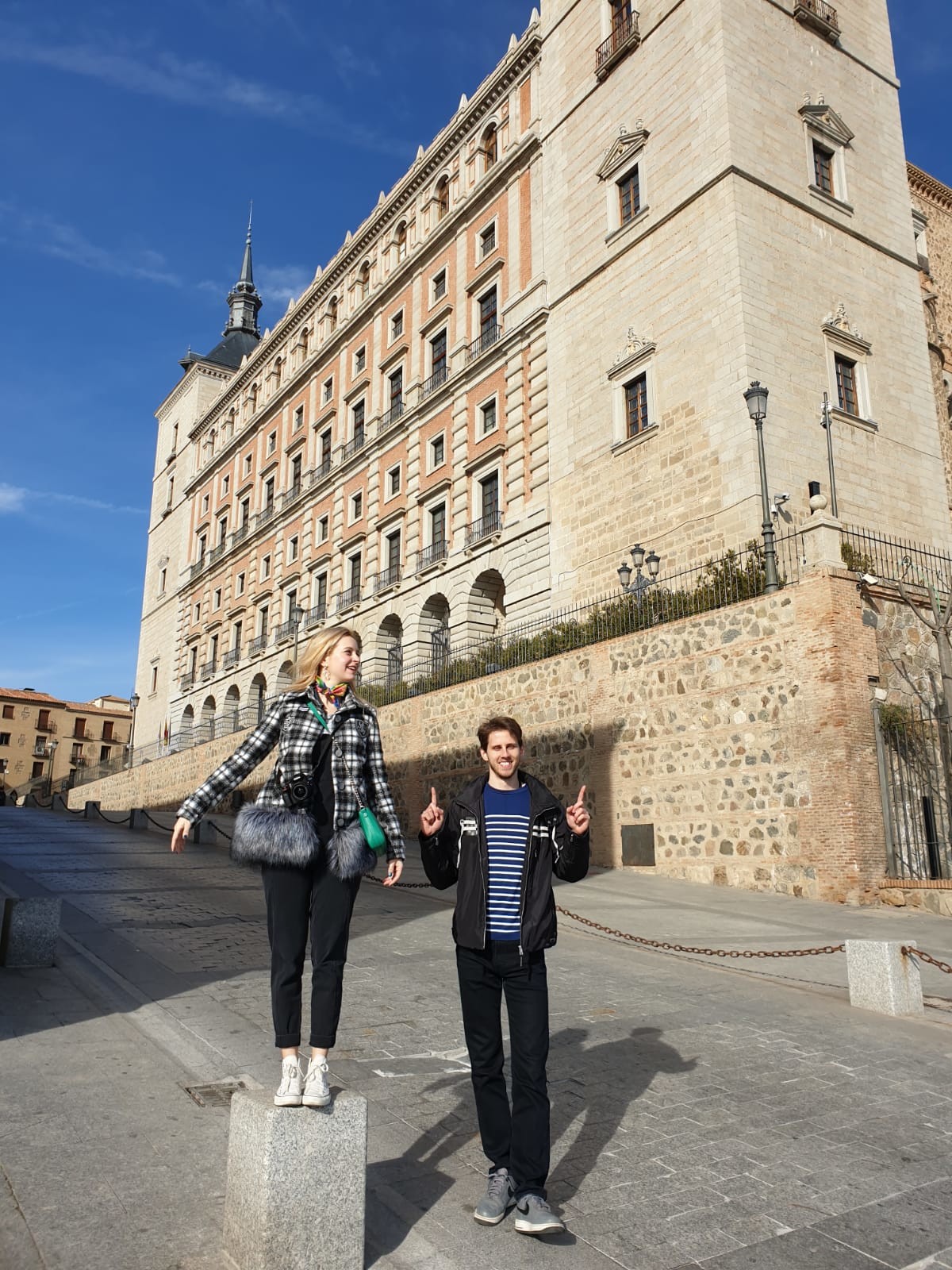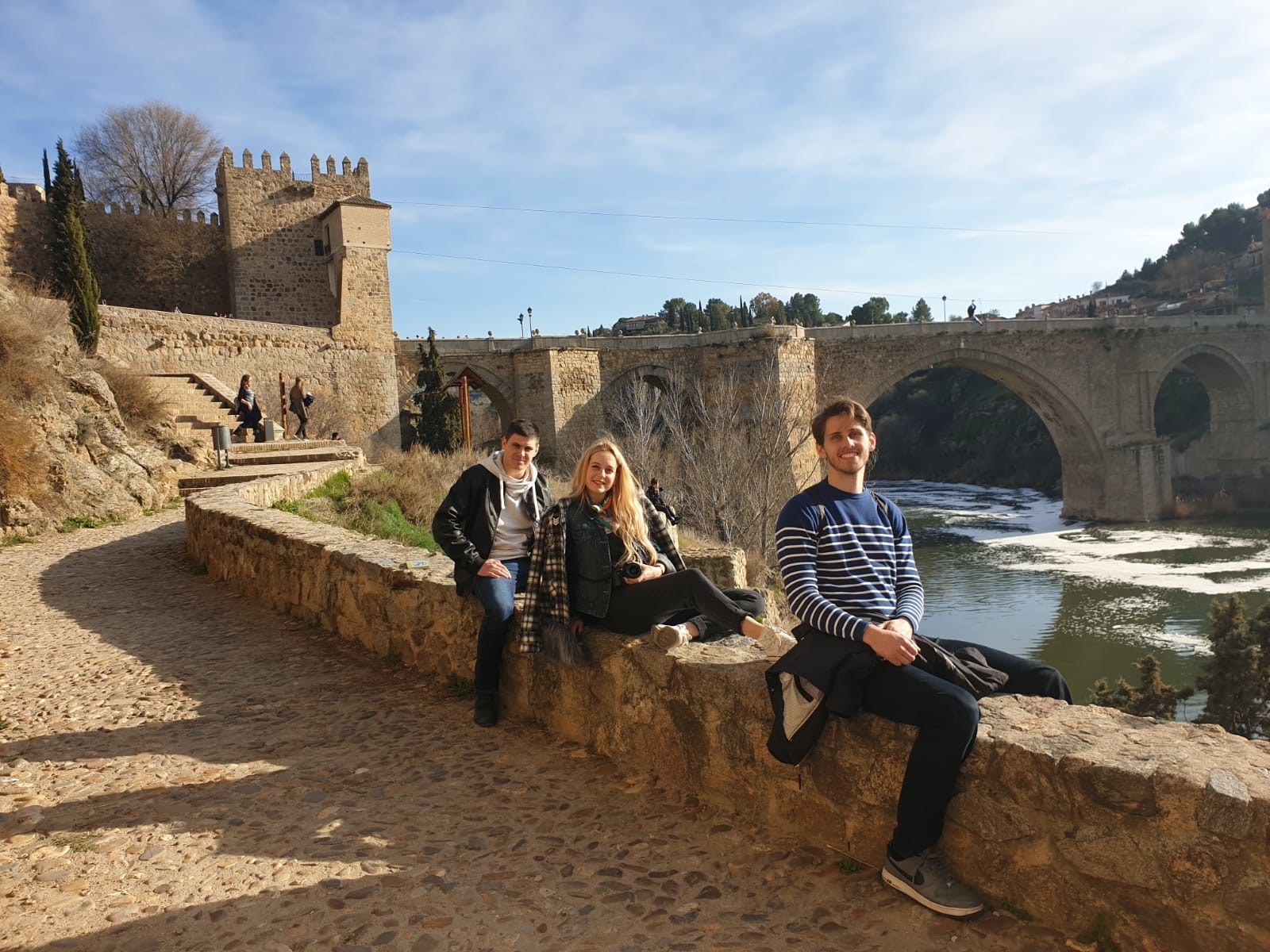Helol guys,
How was my Sunday?
Fortunately for me, I am very interested in architecture and exploring new places, and my Erasmus society was interested in going to the old capital of Spain, about seventy kilometers from Madrid - the city called Toledo.

As I was preparing myself for starting school in Madrid, I encountered no less amazing comments about Toledo than I heard about Madrid. Even in Serbia, I decided to try to find the company interested in going to Toledo with me and on the thirteenth day of my stay in Madrid, after one week away from home, on sunny morning, we have traveled to the historic capital of Spain - Toledo, a place with culture and spirit.
A thing that you should pay attention on is that I was taking a bus which is free because I have a monthly transport card, which provided me with many free travel locations. So we went full of excitement, open to the mood and absorption of the spirit of the old city which, I'm sure, offers a lot of things.

Toledo is famous for its tradition and antiquity. The first encounter and a look at Toledo justified out arrival. The town was built on the hill, and the real picture is only from the surrounding hills, since it was explained to me that El Greko with just one of these hills pictures have made the landscape of Toledo, my romantic mast was worked out right now and I thought that if he was standing on the bass of this hill where exactly I am and I stand after so many years ... just wow...
A special painting is the Taho River that surrounds the city and it looks like a heavenly air halo witch hold it to this day. When we came close to the gate in the shape of a wall through which it was supposed to pass, so then we could see the image of a big square. Fascinating...

During every trip, it’s important to enjoy local food and sweets, so now, about something really important for Toledo, something old and sweet... marzipan. It is said that the Spanish stewards are responsible for this delicious creation. Colors and fragrances... everything made with almond, nut, zum, sugar, honey, pumpkin, chocolate... and who knows what else... for these reasons we saw a lot of candies that were significantly represented by this beautiful town, and we have bought some perfectly packed marzipan in transparent boxes - the gods that all of us tried and tasted... (and some of us can still feel the taste :))
What is known today as well, Toledo owes the Moors, who planted the stalks of almonds and whose fruit was milled with additional sugar, that makes marzipan. We have read in our tourist guide that we should not come in Toledo and try the marzipan, which is made in all possible shapes and colors, full of yolks, honey, pumpkin and sugar, or (in Moroccan way) mixed with orange juice or rose water before the modeling... it would really be a failure. Highly recommendation was to go to the gourmet shop "Santo Tome" for manual production and marzipan shaping, where you will hear interesting stories about the history of the marzipan. Some in Spain claim that the Spanish nuns are being credited for the invention of the marzipan, and not the Moors. Even though I found homemade cakes that made nuns and I have bought it in a monastery, which you will find if you are strayed in the streets of the street.
After sensory bombing, we went on a tour of the city. From the main square, there are numerous narrow streets with a few houses. Not even more streets, nor a smaller city witch contains so many streets. But these streets can be sorted by Arab houses, synagogues, palaces, Gothic churches, and then monasteries (Konvento de Santo Domingo Antigo) and houses in mudehar style - a mixture of Arabic style and Gothic (combination of stone and brick). This is what makes Toledo unique, it has kept the tradition and ambience of the medieval city. Urbanistic is so determined that today's construction must be just of brick and stone. After the Romans and Visigoths, in the 8th century, the Moors lived in Toledo, during the Middle Ages and before the arrival of Christians, there was a very significant Jewish community in the city. Because of this, you can see two synagogues of Santa Maria la Blanca and Del Transito in the city today, where you can see the museum's history of the history of the Jews in the Iberian Peninsula. In addition to Jewish synagogues, Toledo has few remains of the Moorish heritage, such as the Mesquita del Cristo de la Luz from the 10th century - the only remaining mosque to which the Christians changed the name and palace of Taljer del Moro. In this part of the Old Town there are many souvenir shops, specific for the city. Since you are bitching and making swords here, you can buy them at a price of 25 to 600 euros. You will find in the shops that you sell them from all periods: from the Templar, Crusades, Knights to the copies of those used in Hollywood films with a medieval or martial arts theme. You can buy and complete knightly armor, medieval shields with coats of arms that seem to have come out of a museum.

Countless small paved streets, church monasteries, synagogues, houses from which the radius of history... which in modern conditions of construction kept the old style, brick, stone... everything... a 10th century mavarian mosque, which the christians later changed their name ... so many shops and especially the point of the mosque shop...
We arrive and come to the most striking and most memorable churches of the Gothic cathedral that really do. From the inside, breath, gold and many precious stones, and some of the paintings of El Greco, from which one sloth originated from that hill already mentioned, comes to an end. Anyway, it's interesting to know that El Greco in Greek means Greek, because he came to Crete to Toledo to be a painter to the Spanish king, and so he fell in love with Toledo and stayed there ... We were not told that there was a house there somewhere in which he lived and many of his works in it ... The most famous church of Toledo is certainly the Gothic cathedral, built from the 13th to the 15th century, in which besides the grandiose interior and treasures of golden, platinum and gemstone items, it is obligatory to visit the museum a part of. That's where I stayed the most. The museum houses some of the most beautiful paintings by El Greco, Tietian, Rubens, Caravaggio and others. In addition to her, another church that must be Iglesia de Santo Tome, which contains the most famous painting of El Greco "The Orgas of the Count of Ghana." Many artists' inspiration, peace and painting by Dominicos Theotokopoulos found in Toledo. Born in Crete, studied in Italy, he came to Toledo as a court painter of the Spanish king Philip II to perform the iconostasis on the famous Sant Lorenzo del Eskorial project, where he received the nickname El Greco, in Spanish, meaning "Greek." In Toledo, there is a house claimed to be the place where he lived - Muzeo del Greco, so his works are there.
One of the special stories is the river from which there is a beautiful city on one side, and on the other, a lot of greenery and life on it, ducks and geese that float during the recess of history and give her life in the present ... The greatest revelations of the city are the pictorial coasts of Rijeka, and so far away from the crowds in the central historical part of the city, at the top of the hill. At the foot of the medieval bridges of Puente de San Martin and Puente del Alcantara, which connect Toledo with the neighboring hill, along the coastline around the Old Town, there is a promenade, that is the earthy road that looks only locals because there is no tourist at all. While looking from the base, on the one hand, you reach the toledan houses, whose façades are on the cliff some 150 meters above you, on the other side of the river, birds nest in the high walls, and dives and ducks float by the river. In several places along the river, in order to slow it down (in order to supply the city with water), in the old days, cascades were made, along the other side of which there are remains of Arab mills. In the late afternoon, we moved the end of one of them and enjoyed the hook of the river, cooling the feet in shallow green water. On the rim of the river, outside the city crowd, there are several houses in which people live in a completely different way from their fellow citizens in the center, just 100 meters above. They graze the gardens, feed the goose and sit on the benches by the river, in an almost idyllic atmosphere. With this picture, I'm leaving Toledo in Madrid.

Time is caught in this city, some people live in antique conditions, feeding ducks, sitting by the river on benches... one word - peace and only the peace which has met us with we our desire to return to the sunset of a beautiful day ...
With love,
Isidora
